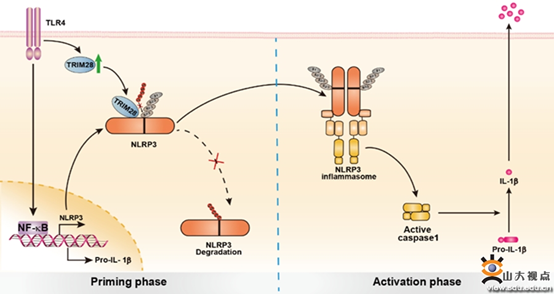Recently, Professor Zhao Wei and his team from the school of basic medicine of Shandong University made new progress in the study of NLRP3 inflammasome. The relevant research results were published online in the journal Nature communications under the title of "trim28 aggregates and stabilizes NLRP3 to facilitate inflammasome activation" (First District of Chinese Academy of Sciences, five-year if = 15.805). Qin Ying, a doctoral student of the school of basic medicine of Shandong University, is the first author of the paper, and Professor Zhao Wei is the corresponding author. Shandong University is the independent first and corresponding author of the paper.
NLRP3 inflammasome is a protein complex formed by multiple molecules including NLRP3, which can recognize pathogen infection and activate intracellular danger signals, induce the maturation and secretion of cytokines IL-1β and IL-18, and cause cell scortosis.It plays an important role in antiviral, inflammation and other physiological and pathological processes. Viral infection causes intracellular ROS production and organelle damage, and acts as a danger signal to activate NLRP3 inflammasome, resulting in the release of a large number of inflammatory factors in a short period of time, which is the key to multiple organ damage caused by viral infection.NLRP3 protein expression is a key rate-limiting step in inflammasome activation and an ideal target for prevention and control of excessive inflammation caused by viral infection. Zhao's team identified several molecules that bind to NLRP3 through screening, including THE E3 SUMO ligase TRIM28.TRIM28 specifically binds NLRP3 and promotes its SUMO1, SUMO2 and SUMO3 modifications, thereby inhibiting NLRP3 ubiquitination and protein degradation, and promoting NLRP3 expression and inflammasome activation. This study reveals the interaction between two post-translational modifications of NLRP3 (sumoylation and ubiquitination) and the mechanism by which they fine-regulate inflammasome activation. It also provides a new potential target for the prevention and control of diseases related to abnormal activation of inflammasome.
Paper link: https://www.nature.com/articles/s41467-021-25033-4







